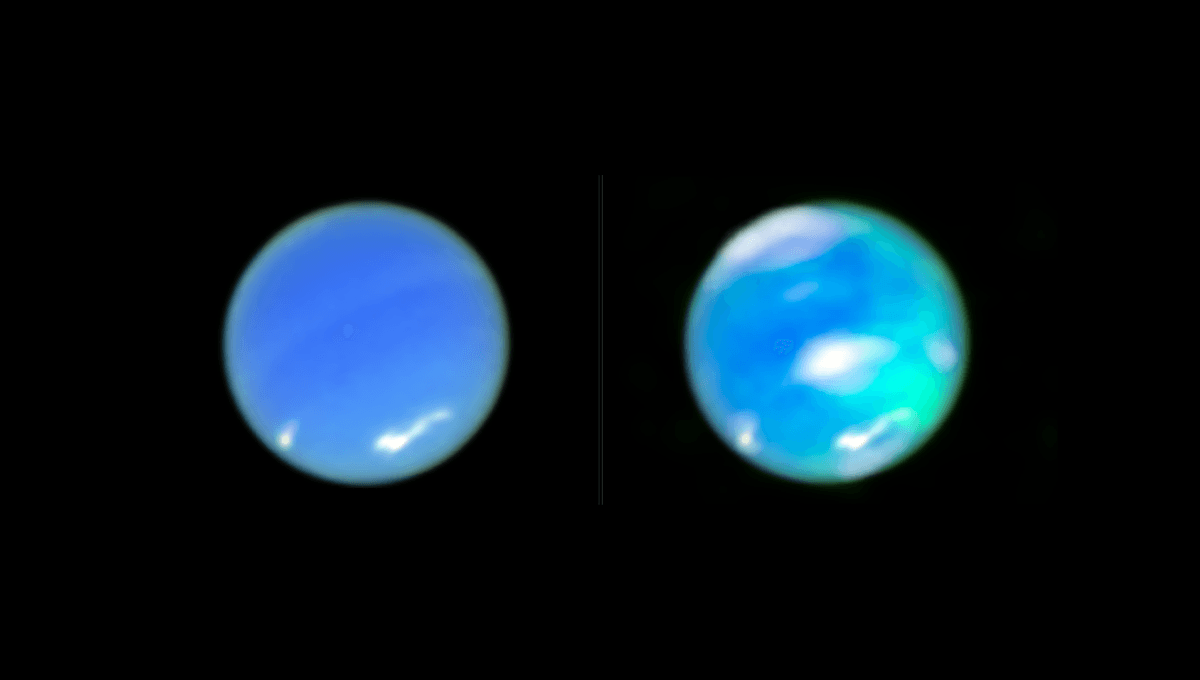
Thirty-six years after the first hints of auroral activity on the ice giant, astronomers have captured Neptune’s aurorae for the first time. Thanks to JWST, the planet’s elusive glow has been measured and it’s not the only new insight these observations have delivered. The planet is colder now than back in 1989 when Voyager 2 visited it.
ADVERTISEMENT
Aurorae are light displays caused by electrically charged particles interacting with the planets of our Solar System. As well as Earth, they have been seen on Mars, Jupiter, Saturn, Mercury, Venus, and Uranus – Neptune marks the first time the full set has been confirmed – as well comets, like Comet 67P/Churyumov-Gerasimenko. Though what causes the auroras and how they appear may differ on some planets, it was only a matter of time before we found them on Neptune, too.
Finding aurora on Neptune is probably the funnest result I have ever had.
Henrik Melin
“Finding aurora on Neptune is probably the funnest result I have ever had,” lead author Henrik Melin of Northumbria University, who conducted the research while at the University of Leicester, told IFLScience.
“This is the quadfecta, completing the set of observing auroral emissions from all of the four giant planets in the infrared. We knew it should be there since Neptune has all the ingredients you need to create aurorae, but we were never able to detect it using telescopes on the ground.”
The extraordinary capabilities of JWST‘s near-infrared instrument allowed these observations. The team measured the temperature of the planet as well as the distribution of the trihydrogen cation (H3+) which has been often associated with the aurorae. The distribution of these ions is consistent with the location of the aurorae, which is not near the poles, like we see on Earth. This is because the magnetic field of Neptune is severely skewed; Voyager 2 showed it is tilted 47 degrees from the planet’s axis of rotation.
“H3+ has been a clear signifier on all the gas giants — Jupiter, Saturn, and Uranus — of auroral activity, and we expected to see the same on Neptune as we investigated the planet over the years with the best ground-based facilities available,” co-author Heidi Hammel of the Association of Universities for Research in Astronomy explained in a statement.
ADVERTISEMENT
The other surprise of the researcher is the planet’s temperature. Neptune’s upper atmosphere is twice as cold as it was in 1989. This drop in temperature is likely to have weakened the aurorae signal, making it difficult to detect the aurorae.
We’re lucky to have a brand new JWST programme that will observe Neptune over the course of a month in 2026. It’s very exciting because we’re exploring a world we know very little about, so there’s so much new to learn.
Henrik Melin
“The JWST observations reveal the physical conditions of the upper atmosphere and showed that this part of the atmosphere has significantly cooled since the Voyager 2 flyby in 1989. This was a huge surprise! Even though Neptune is very far from the Sun, it still has a really dynamic upper atmosphere,” Melin told IFLScience.
These groundbreaking observations of Neptune are incredible insights into the farthest planet in the Solar System but they are also just a taste of things to come in the next few years thanks to the JWST.
ADVERTISEMENT
“This pilot study shows that JWST is the tool we can use to characterise the aurorae, and how it changes over time, which tells us about the planet’s magnetic field and how it interacts with the surrounding space environment. We’re lucky to have a brand new JWST programme that will observe Neptune over the course of a month in 2026. It’s very exciting because we’re exploring a world we know very little about, so there’s so much new to learn,” Melin told IFLScience.
The results have been published in the journal Nature Astronomy.
Source Link: Neptune’s Lost Aurorae First Hinted At 36 Years Ago Has Been Captured For First Time